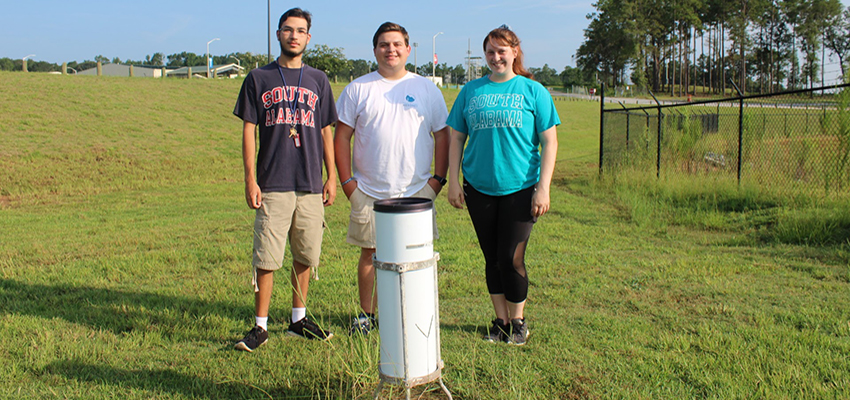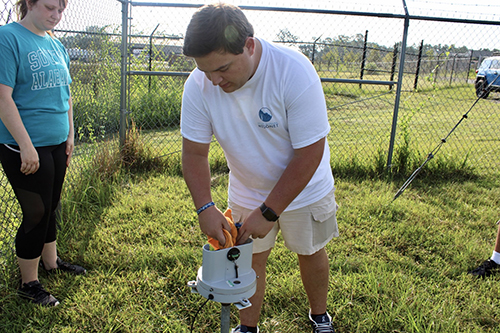South Alabama Mesonet Tracks Rainfall Records Around North-Central Gulf Coast
Posted on September 9, 2021 by Zoe Blair

This year’s rainfall amounts in Mobile have been trending above average, and the University of South Alabama Mesonet has been tracking the records. Located in the north-central Gulf Coast area, the Mesonet is a network of 26 automated weather stations founded in 2004 by South meteorology professor and Earth Sciences Department Chair Dr. Sytske Kimball.
“In June 2021, all of the South Alabama Mesonet stations recorded more than the normal 6.55 inches,” Kimball said. “The stations in Agricola, Miss., and on the University of South Alabama campus recorded the highest rainfall amounts: 16.09 and 15.26 inches, respectively. Agricola also reported the most days with rainfall; it rained for 24 days out of the 30 days in June 2021. Ten Mesonet stations reported a day with more than 3 inches of rain.”
Normal rainfall amounts are based on averages calculated over 30 years (1991 through 2020). The normal rainfall amounts for May, June and July are 5.39, 6.55, and 7.69 inches, respectively. This year, the Mobile Regional Airport measured much more: 5.95 (May), 14.22 (June), and 8.05 (July) inches.
“June was extremely rainy, with 7.67 inches more than normal recorded at the airport,” Kimball said. “In June, the airport saw six days with more than half an inch of rain and four days with more than 1 inch of rain. The rainiest 24 hours occurred from 7:00 a.m. on June 18 through 7:00 a.m. on June 19 when tropical storm Claudette affected the area.”
Hurricane Ida’s landfall on August 29 brought two and a half days of torrential downpours, and most areas in Mobile saw between five and 10 inches of rain. Areas such as Wilmer got the brunt of the precipitation as they received 11.24 inches of rain.
The Mesonet weather stations collect 16 meteorological- and soil- quantities including temperature, rainfall, wind speed and direction, soil temperature and humidity. Measurements are made automatically every minute of the day, every day of the year. The Mesonet is entirely funded through grants and donations to support routine maintenance (removing vegetation and animal nests), sensor replacement/repair, calibration of instruments and to pay student workers.
 Logan Smith, a meteorology major in the College of Arts and Sciences, is one of the
students that helps Kimball maintain the Mesonet system.
Logan Smith, a meteorology major in the College of Arts and Sciences, is one of the
students that helps Kimball maintain the Mesonet system.
“The Mesonet has given me an opportunity that not many college students get,” said Smith, who is from Ardmore, Ala. “I get to work hands-on with all kinds of weather instruments. This has given me invaluable work experience in my future field, and I will have a leg up when searching for a job in the future.”
Mesonet weather station data have inspired a wide variety of research projects at the University of South Alabama addressing local weather events and phenomena including cold fronts, landfall of tropical storms, sea breezes, nocturnal cooling, and local wind and rainfall climatologies.
“The weather stations and their data are used in the meteorology curriculum at the University of South Alabama,” Kimball said. “Meteorology majors can take a class in meteorological instrumentation, get involved in weather station maintenance, social media outreach and participate in research projects using Mesonet data.”
The Mobile National Weather Service forecast office uses the data on a frequent basis to issue severe weather and flash flood warnings and to perform post weather event analyses. Thirteen stations are located on local public school campuses and are used for K-12 outreach activities. The Mesonet serves the wider Gulf Coast community in a wide range of applications including agriculture, ecosystem monitoring, fire weather, recreation, renewable energy, air quality and health, emergency management, litigation and climate change.
Why did it rain so much this June? Dr. Keith Blackwell, professor emeritus in the Earth Sciences department of the University of South Alabama and former Coastal Weather Research Center consultant, explained why this summer was so unusually rainy.
“You probably remember the extreme heatwave in the West and Pacific Northwest during the month of June,” Blackwell said. “That was due to a persistent unusual upper-level ridge over that area, pushing the jet stream abnormally far north. Well, in response, persistent troughing persisted ‘downstream’ over the southeastern U.S. This resulted in cooler-than-normal weather in the southeast and more fronts than usual in the northern Gulf Coast. A large number of fronts would move south and then go stationary across the northern Gulf Coast states, providing enhanced convergence and a "focusing mechanism" for repeated outbreaks of thunderstorms. Thus, we had a very wet June. Also, we had Tropical Storm Claudette making landfall on the northern Gulf Coast in mid-June, bringing even more rain to the area.”
Pete McCarty and Corey Bunn from the University of South Alabama’s Coastal Weather Research Center agree with Blackwell’s assessment. “Closer to the Gulf Coast, a more localized feature, the sea breeze, also contributes to the occurrence of shower and thunderstorm activity,” the two shared in a report. “Moisture is pulled northward around the western extent of the Bermuda High and with the aid of daytime heating and the afternoon sea breeze, scattered to numerous showers and thunderstorms can develop on any given day over the Southeast.”
Mesonet data can be found online here and can be used by anyone interested.
“While the data is free, providing this research-quality data is not,” Kimball said. “We pay students to maintain the weather stations and their instruments, using grant money. This is also a good educational experience for South meteorology majors. If you are in a position to help support this important community resource, please feel free to do so. We would really appreciate your help.”


